INNA LEKCJA
Lekcja metodą projektów to właściwie kontrakt podpisany między uczniem a nauczycielem, umowa, która obowiązuje obie strony.
Uczniowie podejmują się pracy, którą wykonują samodzielnie pod kierunkiem nauczyciela - nauczyciel stawia zadanie, wyjaśnia jak je wykonać i w końcu ocenia.
Uczniowie sami rozwiązują problem, przydzielają sobie role w wykonaniu pracy - w zależności od preferencji i chęci, ale każdy ma coś do zrobienia, nieważne jak mała byłaby to część, od niego zależy całość - wynik i końcowa ocena.
Chciałabym zaprezentować prace uczniów klas maturalnych.
Tematem lekcji:
"Wynalazki, które zmieniły świat"
(w wersji angielskiej temat brzmi:
"Great inventions how have they changed the world").
Jako, że pracuję w szkole technicznej, temat ten wzbudził żywe zainteresowanie, padło wiele przykładów i propozycji prac.
Ostatecznie uczniowie podzielili się na grupy i opracowali kilka najważniejszych wynalazków cywilizacji, m.in.
Pracując nad projektem korzystali z internetu, skanera, ksero i różnych materiałów źródłowych np. encyklopedii.
Projekty są ciekawie opracowane, zawierają wiele cennych informacji, fotografie i rysunki oraz co bardzo ważne słowniczek trudnych wyrazów. Zresztą zobaczcie sami!
Teresa Smurzyńska
nauczyciel j. angielskiego
w Zespole Szkół Łączności w Krakowie
HISTORY OF CLOCK AND WATCHES
Clocks and Watches, devices used to measure or indicate the passage of time. A clock, which is larger than a watch, is usually intended to be kept in one place; a watch is designed to be carried or worn. Both types of timepieces require a source of power and a means of transmitting and controlling it, as well as indicators to register the lapse of time units.
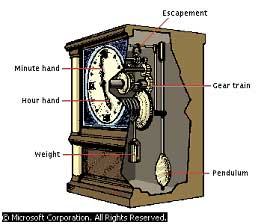
Throughout history, time has been measured by the movement of the earth relative to the sun and stars. The earliest type of timekeeper, dating from as far back as 3500BC, was the shadow clock, or gnomon, a vertical stick or obelisk that casts a shadow. An Egyptian shadow clock of the 8th century BC is still in existence. The first hemispherical sundial was described about the 3rd century BC by Chaldean astronomer Berossus. Ancient methods of measuring hours in the absence of sunlight included the notched candle and the Chinese practice of burning a knotted rope and noting the length of time required for the fire to travel from one knot to the next. Devices almost as old as the shadow clock and sundial include the hourglass, in which the flow of sand is used to measure time intervals, and the water clock, or clepsydra, in which the flow of water indicates passage of time.
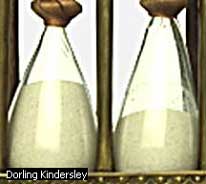 |
Sandglass
Ornate sandglasses like this one were once used to mark the passage of minutes and hours. Flipping the glass causes the fixed amount of sand to pass though its narrow central hole in a consistent length of time, creating a relatively accurate measure. Generally called hourglasses because an hour was their standard setting, almost any period of time could be set by altering the amount of sand or the size of the central opening |
Clepsydras became more complicated, even to the inclusion of gearing in about 270BC by Greek inventor Ctesibius of Alexandria. Eventually, a weight falling under the force of gravity was substituted for the flow of water in time devices, anticipating the mechanical clock.
The Mechanical Clock
The historical origin of the mechanical clock is obscure. The first recorded examples are found in the 14th century. Until that time, a time-measuring instrument was known as a horologium, or hour teller. The name clock, which originally meant "bell," was first applied in the present sense to the huge, mechanical time indicators installed in bell towers in the late Middle Ages.
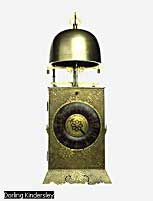 |
Japanese Lantern Clock
This Japanese clock was regulated by weights on a moving balance bar. Called a lantern clock because of its distinctive shape, it features the one-hand design common in most clocks until the 1650s. Minute hands appeared when Christiaan Huygens designed the more accurate pendulum clock |
The Pendulum
A series of inventions in the 17th and 18th centuries increased the accuracy of clockworks and reduced the weight and bulk of the mechanisms. Galileo had described late in the 16th century the property of a pendulum, known as isochronism, stating that the period of the swing is constant. In 1657 Dutch physicist Christiaan Huygens showed how a pendulum could be used to regulate a clock. Ten years later English physicist Robert Hooke invented an escapement, which permitted the use in clocks of a pendulum with a small arc of oscillation. British clockmaker George Graham improved the escapement, and John Harrison developed a means of compensating for variations in the length of a pendulum resulting from changes in temperature.
Watches
Watchworks were developed when coiled springs were introduced as a source of power. This type of spring was used in Italy about 1450. About 1500 Peter Henlein, a locksmith in Nürnberg, Germany, began producing portable timepieces known popularly as Nürnberg eggs. In 1525 another artisan, Jacob Zech of Prague, invented a fusee, or spiral pulley, to equalize the uneven pull of the spring. Other improvements that increased the accuracy of watches included a spiral hairspring, invented about 1660 by Robert Hooke, for the balance wheel, and a lever escapement devised by British inventor Thomas Mudge about 1765.
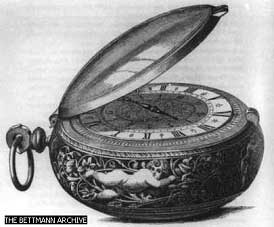 |
Pocket Watch
This engraving depicts a Nüremberg egg, a pocket watch designed by Peter Henlein in the early 16th century. Small, portable clocks like the Nüremberg egg became possible with the development of coiled springs as a power source for timekeeping devices |
Minute and second hands, and crystals to protect both the dial and hands, first appeared on 17th-century watches. Jeweled bearings to reduce friction and prolong the life of watchworks were introduced in the 18th century.
ELECTRIC TIMEPIECES
The quartz-crystal clock developed in 1929 for precision timekeeping employs a ring of quartz that is connected to an electrical circuit and made to oscillate between 10,000 and 100,000 hertz (cycles per second). The high-frequency oscillation is converted to an alternating current, reduced to a frequency more convenient for time measurement, and thus made to drive the motor of a synchronous clock or a digital display. The maximum error of the most accurate quartz-crystal clocks is plus or minus one second in ten years.
The electric or electronic watch is powered by a small battery that functions for about one year without replacement. The battery may drive the balance wheel of an otherwise mechanical clock, or it may be used to drive the oscillations of either a small tuning fork or a quartz crystal.
ATOMIC CLOCKS
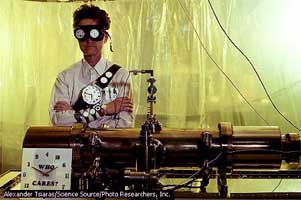 |
Atomic clock
Jim Gray is keeper of the NBS-4 atomic clock at the National Institute of Standards and Technology. Some atomic clocks lose or gain only one second every 200,000 years |
The most precise timekeeping devices are atomic clocks. Their uses include measuring the rotation of the earth, which may vary by 4 to 5 milliseconds per day, and aiding navigational systems such as the global positioning system in computing distances. Atomic clocks are tuned to the frequency of the electromagnetic waves that are emitted or absorbed when certain atoms or molecules make the transition between two closely spaced, or hyperfine, energy states. Because the frequency of these waves is unaffected by external forces, the corresponding period of the waves can be used as a standard to define time intervals.
The cesium-atom clock is very accurate and remains stable over long periods of time. The most stable cesium-atom clocks have an error of about plus or minus one second in one million years.
FUTURE
Scientific advances in metallurgy and other fields have led to many improvements in timekeeping devices of all types. The mainsprings of present-day mechanical watches are made from metals that resist breakage and rust, synthetics have replaced precious stones in jeweled bearings, and cases have been perfected that seal out both dust and moisture. Other special-purpose watches include the Braille watch for the blind, which has sturdy hands not covered with a crystal, and raised dots on the dial to mark the hours; the alarm watch for the pocket or wrist, which functions as a tiny, portable alarm clock; and the calendar watch, which shows the day of month and the week. New sources of power, such as sunlight, body heat, and atomic energy, are being investigated in current horological research.
Vocabulary:
- Device - urządzenia
- Intend - przeznaczać
- Indicator - wskazówka
- Notch - nacięcie, wycięcie
- Obscure - nieznany
- Bulk - ogrom
- Arc - łuk
- Friction - tarcie
- Transition - przejście (od czegoś do czegoś)
- Mainspring - główna sprężyna
- Rust - rdza
- Sturdy - silny
-
Opracował: Maciej Mynart, kl. 5K 15.04.2002
(
plik w formacie MS Word)
<< w górę
Invention of the cars.
The birth of the car as we know it today occurred over a period of years. It was only in 1885 that the first real car rolled down on to the streets. The earlier attempts, though successful, were steam powered road-vehicles.
The first self-propelled car was built by Nicolas Cugnot in 1769 which could attain speeds of up to 6 km/hour. In 1771 he again designed another steam-driven engine which ran so fast that it rammed into a wall, recording the world's first accident.
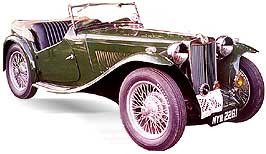
In 1807 Francois Isaac de Rivaz designed the first internal combustion engine. This was subsequently used by him to develop the world's first vehicle to run on such an engine, one that used a mixture of hydrogen and oxygen to generate energy.
This spawned the birth of a number of designs based on the internal combustion engine in the early nineteenth century with little or no degree of commercial success. In 1860 there after, Jean Joseph Etienne Lenoir built the first successful two-stroke gas driven engine. In 1862 he again built an experimental vehicle driven by his gas-engine, which ran at a speed of 3 kms/hour. These cars became popular and by 1865 could be frequently espied on the roads.
- steam-driven engine - silnik parowy
- to ram - taranować
- internal combustion engine - silnik o spalaniu wewnetrznym
- subsequently - później
- to spawn - zapoczątkować
- two-stroke - dwusuwowy
How did people move when there were no cars?
Human beings have been constructing roadways for over six thousand years.
Travelling on horseback
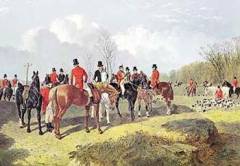
People were moving on foot,but it wasn't a good means of transport for long distances. The best way to move in ancient centuries was travelling on horseback.
Horses were able to carry heavy loads for hours.
In the 19th century, there was no match for the horse for swift travel and communications.
Early roadways carried pedestrians, hoofed animals, and simple wheeled vehicles such as wagons.
- on horseback - na koniu
- means of transport - środek transportu
- load - ładunek
- swift - szybki
- pedestrian - pieszy
- hoofed animals - zwierzęta kopytne
- vehicle - pojazd
- wagon - wóz
Chariots and wagons
Chariots were one of the wheeled vehicles that the human invented. Wheels helped transporting people instead of walking everywhere.
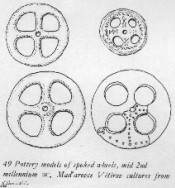 |
First wheels |
This was helpful, expecially in taking royal people to different places. Since wheels roll they are easy to pull and so, the people decided to attach them to vehicles.
 |
First chariots |
- chariot - rydwan
Future
The modern automobile, comes from a long list of ancestors.The car of the future will be more economical and safe.Today we can't imagine life without the basic means of transport.Cars are everywhere and I thing that it will be very difficult to invent a vehicle which could repleace automobile.
- ancestor - przodek
Opracował: Krystian Stus, 10.04.2002
(
plik w formacie MS Word)
<< w górę
The First Steps in Telecommunications
From time immemorial people communicate in different ways. First, they used smoke signals, then carrier-pigeons. Subsequently they used more advanced methods like flag signalling system. We can't forget about messengers on their horses, who played a big role in sending information. During the Napoleon's war an optic telegraph was invented. Since 19th century we can see the fast development of new technologies. Each year was bringing new inventions. Starting by the electric telegraph (Samuel Morse - 1844). First intercontinental wire was sent by Qeen Victoria to the USA President (Buchanana - 1858). The first fax was sent from Lyon to Paris in 1865. Telephone was constructed by Scotch inventor Alexander Graham Bell.
Drum Telegraphs

In areas of forest, which are difficult to see through, the drum telegraphy developed as a means of telecommunication. Above all the natives of Africa, New Guinea and the tropical America introduced drum telegraphy. When scientific expeditions came to the jungle, to explore the primeval forest, they were accompanied by a never-ending roar of signal drums. So the message of their coming and their intention was carried through the woods always a step in advance. In the old China, people used the "Tamtam" as a telecommunication appliance , a big, free hanging, circular plate of metal. The keystroking of this plate created a far-reaching audible tone.
- the drum - bęben
- natives - ludzie miejscowi
- scientific expedition - naukowa wyprawa
- appliance - przyrząd
-
Fire Signaling

The old Greece and the Roman empire already possessed good organized telegraph systems. Fire signals were given from mountain to mountain or from tower to tower. The Greek poet Aischylos, a soldier in the fight of Marathon, describes in one of his poems a "fire post", probably the first line of sight transmission in the world. With this system the fall of Troja is said to have been reported to Argos. Especially sensible was a torch telegraph, which was invented about 2500 years ago by the two Alexandrian engineers Kleoxenos and Demokleitos. It was to be used only at night. The receiving and transmitting station was built of two separated walls, which were placed on hills. Each one had battlements between where torches were put. Depending on how many torches were burning between the battlements on the right and the left wall, the message could be read. For the message "One hundred Cretans have deserted" 173 torch signs were to be used and it took half an hour for the transmission.
- fire post - poczta ogniowa
- torch - pochodnia
-
Water Telegraph

In the year 360, "Aeneas the Tactician" describes in his book, "The Art of Beset", his invention of a hydro-optical telegraph. His basic idea was to store the signals of earlier torch telegraphs so they could be read at a later time. At both telegraph stations equivalent water vessels with taps were posted. With torch signals, orders were given to open and close the taps. This way the level of the water within the vessel sank. In advance there were messages assigned to every level of the water. On the one hand you couldn't send any message you wanted, but on the other hand you could store a message.
- hydro-optical telegraph - hydro-optyczny telegraf
- the taps - zawory
- a message - wiadomość
-
Smoke Signaling
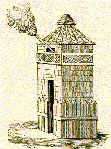
Not only Indians were using smoke signals to exchange information, but also in 150 AC the Romans were working with a smoke telegraph net, which had a total length of about 4500 kilometers. It was an optical signal net with arranged smoke signs. The telegraph net consisted of towers within visible range of each other. Hundreds of such towers for military signaling were needed to be able to reign over such a fast expanding empire.
- exchange information - wymiana informacji
- arrange smoke signs - rozmieszczać znaki dymne
-
Claude Chappe
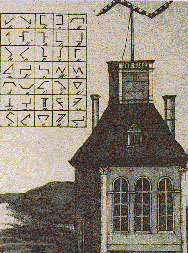
The first development of a useful optical telegraph was in the time of the French Revolution, the epoche of the arising capitalism. The Revolutionary France was threatened by inner and outer opponents. This situation made a new communication system necessary. The civilian Claude Chappe, a former priest, invented a mechanical-optical telegraph. It consisted of a column with a moveable crosswise beam. This beam also had two moveable arms. With ropes it was possible to show many different signal pictures, all together 196 (with upper and lower case letters, punctuation marks and numbers). The equipment stood on rooftops or towers and was visible from afar. The first telegraph line of this sort was put into operation in 1794.
In this time corps of voluntary soldiers were defending France against Austria and other Feudal Powers.
The telegraph line consisted of 22 stations and linked Lille with the capital Paris, a distance of over 240 kilometers. It only took 2 to 6 minutes to transfer a message, riding couriers would have needed 30 hours. In 1894, when the revolutionary army conquered back the city Le Quesnoy, the message of this event was already in Paris one hour later, but only because there was no fog!
- epoche of the arising capitalism - epoka powstawania kapitalizmu
- mechanical-optical telegraph - mechaniczno-optyczny telegraf
- moveable arms - ruchome ramiona
- afar - w oddali
- corps - korpus
-
Development of Telephone Technology
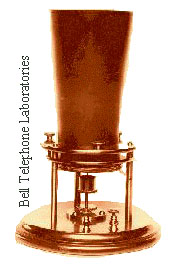
A pioneer in the field of telecommunications, Alexander Graham Bell was born in 1847 in Edinburgh, Scotland. He moved to Ontario, and then to the United States, settling in Boston, before beginning his career as an inventor. Throughout his life, Bell had been interested in the education of deaf people. This interest lead him to invent the microphone and, in 1876, his "electrical speech machine," which we now call a telephone. News of his invention quickly spread throughout the country, even throughout Europe. By 1878, Bell had set up the first telephone exchange in New Haven, Connecticut. By 1884, long distance connections were made between Boston, Massachusetts and New York City.
Bell imagined great uses for his telephone, like this model from the 1920s, but would he ever have imagined telephone lines being used to transmit video images? Since his death in 1922, the telecommunication industry has undergone an amazing revolution. Today, non-hearing people are able to use a special display telephone to communicate. Fiber optics are improving the quality and speed of data transmission. Actually, your ability to access this information relies upon telecommunications technology. Bell's "electrical speech machine" paved the way for the Information Superhighway.
The first words spoken on telephone were on March 10th in 1876, when Bell spoke the first complete sentence transmitted by variable resistance transmitter ... "Mr. Watson, come here. I want you!"
As Bell said himself, the great advantage that the telephone had over telegraphy was that it could be used by anyone, as "all other telegraphic machines produce signals which require to be translated by experts, and such instruments are therefore extremely limited in their application, but the telephone actually speaks, and for this reason it can be utilised for nearly every purpose for which speech is employed" 3 (Flammger, 1995)
The telephone itself suffered from problems which were overcome as the technology developed.
- inventor - wynalazca
- fiber optics - włókno optyczne
- improving - ulepszać
-
A look in the future
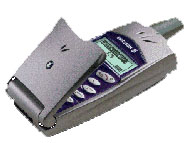
The key words for the future are multimedia and mobile telecommunications. Multimedia communications straddle the traditions of both telecommunications and information technologies. As the technology evolves, it is becoming increasingly difficult to identify the boundary of networks. Now computers, in the form of personal and portable devices, have penetrated broadly in the marketplace. We can anticipate further revolutionary changes in the way computers are used in connection with telephony.
Now computers are able to do all kinds of telecommunications, telephone, data transfer and videophone communications and email, when the computer contains a modem and is connected to the telephone network. Teleshopping and telebanking are also possible. Today and especially tomorrow you can do everything from home. The only problems are now the transmission speed of networks, especially telephone network. Therefore it is necessary to build a new or a better second world-wide network beside the existing telephone network.
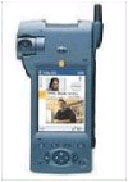
Mobile communications, for example the Cellphones, will be a major role in the future too. It will be cheaper than today and used by more public people. The mobile systems ( Cellphones with notebook) provide a wide variety of services, possibly the same set of services as the fixed network and with the same quality. Communications will be possible from every point in the world.
- evolves - rozwijać
- broadly - zasadniczo
- cheaper - ulgowy
- anticipate - oczekiwać
-
Opracował: Paweł Wójcik 5K, Michał Sośniecki 5K, 15th April 2002
(
plik w formacie MS Word)
<< w górę






 In 1807 Francois Isaac de Rivaz designed the first internal combustion engine. This was subsequently used by him to develop the world's first vehicle to run on such an engine, one that used a mixture of hydrogen and oxygen to generate energy.
In 1807 Francois Isaac de Rivaz designed the first internal combustion engine. This was subsequently used by him to develop the world's first vehicle to run on such an engine, one that used a mixture of hydrogen and oxygen to generate energy. People were moving on foot,but it wasn't a good means of transport for long distances. The best way to move in ancient centuries was travelling on horseback.
Horses were able to carry heavy loads for hours.
In the 19th century, there was no match for the horse for swift travel and communications.
Early roadways carried pedestrians, hoofed animals, and simple wheeled vehicles such as wagons.
People were moving on foot,but it wasn't a good means of transport for long distances. The best way to move in ancient centuries was travelling on horseback.
Horses were able to carry heavy loads for hours.
In the 19th century, there was no match for the horse for swift travel and communications.
Early roadways carried pedestrians, hoofed animals, and simple wheeled vehicles such as wagons.

 In areas of forest, which are difficult to see through, the drum telegraphy developed as a means of telecommunication. Above all the natives of Africa, New Guinea and the tropical America introduced drum telegraphy. When scientific expeditions came to the jungle, to explore the primeval forest, they were accompanied by a never-ending roar of signal drums. So the message of their coming and their intention was carried through the woods always a step in advance. In the old China, people used the "Tamtam" as a telecommunication appliance , a big, free hanging, circular plate of metal. The keystroking of this plate created a far-reaching audible tone.
In areas of forest, which are difficult to see through, the drum telegraphy developed as a means of telecommunication. Above all the natives of Africa, New Guinea and the tropical America introduced drum telegraphy. When scientific expeditions came to the jungle, to explore the primeval forest, they were accompanied by a never-ending roar of signal drums. So the message of their coming and their intention was carried through the woods always a step in advance. In the old China, people used the "Tamtam" as a telecommunication appliance , a big, free hanging, circular plate of metal. The keystroking of this plate created a far-reaching audible tone.  The old Greece and the Roman empire already possessed good organized telegraph systems. Fire signals were given from mountain to mountain or from tower to tower. The Greek poet Aischylos, a soldier in the fight of Marathon, describes in one of his poems a "fire post", probably the first line of sight transmission in the world. With this system the fall of Troja is said to have been reported to Argos. Especially sensible was a torch telegraph, which was invented about 2500 years ago by the two Alexandrian engineers Kleoxenos and Demokleitos. It was to be used only at night. The receiving and transmitting station was built of two separated walls, which were placed on hills. Each one had battlements between where torches were put. Depending on how many torches were burning between the battlements on the right and the left wall, the message could be read. For the message "One hundred Cretans have deserted" 173 torch signs were to be used and it took half an hour for the transmission.
The old Greece and the Roman empire already possessed good organized telegraph systems. Fire signals were given from mountain to mountain or from tower to tower. The Greek poet Aischylos, a soldier in the fight of Marathon, describes in one of his poems a "fire post", probably the first line of sight transmission in the world. With this system the fall of Troja is said to have been reported to Argos. Especially sensible was a torch telegraph, which was invented about 2500 years ago by the two Alexandrian engineers Kleoxenos and Demokleitos. It was to be used only at night. The receiving and transmitting station was built of two separated walls, which were placed on hills. Each one had battlements between where torches were put. Depending on how many torches were burning between the battlements on the right and the left wall, the message could be read. For the message "One hundred Cretans have deserted" 173 torch signs were to be used and it took half an hour for the transmission.  Not only Indians were using smoke signals to exchange information, but also in 150 AC the Romans were working with a smoke telegraph net, which had a total length of about 4500 kilometers. It was an optical signal net with arranged smoke signs. The telegraph net consisted of towers within visible range of each other. Hundreds of such towers for military signaling were needed to be able to reign over such a fast expanding empire.
Not only Indians were using smoke signals to exchange information, but also in 150 AC the Romans were working with a smoke telegraph net, which had a total length of about 4500 kilometers. It was an optical signal net with arranged smoke signs. The telegraph net consisted of towers within visible range of each other. Hundreds of such towers for military signaling were needed to be able to reign over such a fast expanding empire.  The first development of a useful optical telegraph was in the time of the French Revolution, the epoche of the arising capitalism. The Revolutionary France was threatened by inner and outer opponents. This situation made a new communication system necessary. The civilian Claude Chappe, a former priest, invented a mechanical-optical telegraph. It consisted of a column with a moveable crosswise beam. This beam also had two moveable arms. With ropes it was possible to show many different signal pictures, all together 196 (with upper and lower case letters, punctuation marks and numbers). The equipment stood on rooftops or towers and was visible from afar. The first telegraph line of this sort was put into operation in 1794.
The first development of a useful optical telegraph was in the time of the French Revolution, the epoche of the arising capitalism. The Revolutionary France was threatened by inner and outer opponents. This situation made a new communication system necessary. The civilian Claude Chappe, a former priest, invented a mechanical-optical telegraph. It consisted of a column with a moveable crosswise beam. This beam also had two moveable arms. With ropes it was possible to show many different signal pictures, all together 196 (with upper and lower case letters, punctuation marks and numbers). The equipment stood on rooftops or towers and was visible from afar. The first telegraph line of this sort was put into operation in 1794.
 A pioneer in the field of telecommunications, Alexander Graham Bell was born in 1847 in Edinburgh, Scotland. He moved to Ontario, and then to the United States, settling in Boston, before beginning his career as an inventor. Throughout his life, Bell had been interested in the education of deaf people. This interest lead him to invent the microphone and, in 1876, his "electrical speech machine," which we now call a telephone. News of his invention quickly spread throughout the country, even throughout Europe. By 1878, Bell had set up the first telephone exchange in New Haven, Connecticut. By 1884, long distance connections were made between Boston, Massachusetts and New York City.
A pioneer in the field of telecommunications, Alexander Graham Bell was born in 1847 in Edinburgh, Scotland. He moved to Ontario, and then to the United States, settling in Boston, before beginning his career as an inventor. Throughout his life, Bell had been interested in the education of deaf people. This interest lead him to invent the microphone and, in 1876, his "electrical speech machine," which we now call a telephone. News of his invention quickly spread throughout the country, even throughout Europe. By 1878, Bell had set up the first telephone exchange in New Haven, Connecticut. By 1884, long distance connections were made between Boston, Massachusetts and New York City.

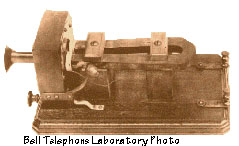
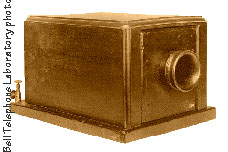
 The key words for the future are multimedia and mobile telecommunications. Multimedia communications straddle the traditions of both telecommunications and information technologies. As the technology evolves, it is becoming increasingly difficult to identify the boundary of networks. Now computers, in the form of personal and portable devices, have penetrated broadly in the marketplace. We can anticipate further revolutionary changes in the way computers are used in connection with telephony.
The key words for the future are multimedia and mobile telecommunications. Multimedia communications straddle the traditions of both telecommunications and information technologies. As the technology evolves, it is becoming increasingly difficult to identify the boundary of networks. Now computers, in the form of personal and portable devices, have penetrated broadly in the marketplace. We can anticipate further revolutionary changes in the way computers are used in connection with telephony.
 Mobile communications, for example the Cellphones, will be a major role in the future too. It will be cheaper than today and used by more public people. The mobile systems ( Cellphones with notebook) provide a wide variety of services, possibly the same set of services as the fixed network and with the same quality. Communications will be possible from every point in the world.
Mobile communications, for example the Cellphones, will be a major role in the future too. It will be cheaper than today and used by more public people. The mobile systems ( Cellphones with notebook) provide a wide variety of services, possibly the same set of services as the fixed network and with the same quality. Communications will be possible from every point in the world.